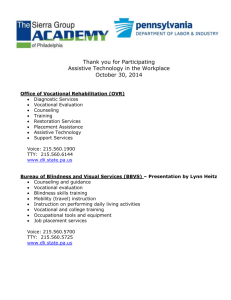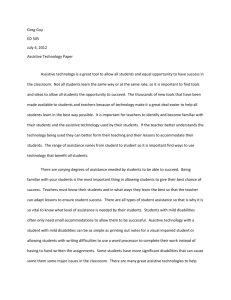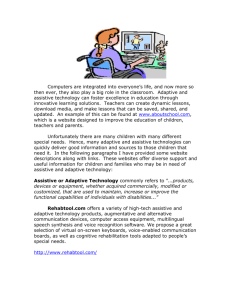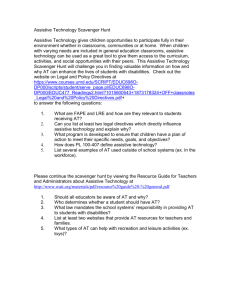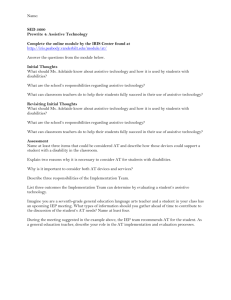Assistive Technology for People with Intellectual Disabilities
advertisement
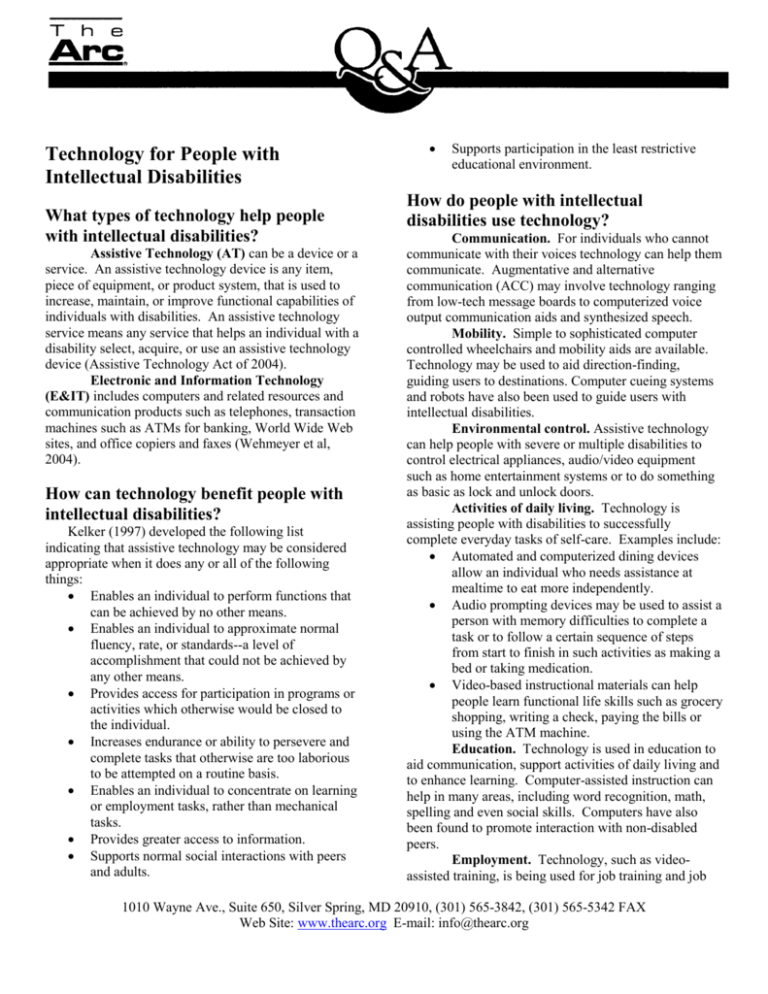
Technology for People with Intellectual Disabilities What types of technology help people with intellectual disabilities? Assistive Technology (AT) can be a device or a service. An assistive technology device is any item, piece of equipment, or product system, that is used to increase, maintain, or improve functional capabilities of individuals with disabilities. An assistive technology service means any service that helps an individual with a disability select, acquire, or use an assistive technology device (Assistive Technology Act of 2004). Electronic and Information Technology (E&IT) includes computers and related resources and communication products such as telephones, transaction machines such as ATMs for banking, World Wide Web sites, and office copiers and faxes (Wehmeyer et al, 2004). How can technology benefit people with intellectual disabilities? Kelker (1997) developed the following list indicating that assistive technology may be considered appropriate when it does any or all of the following things: Enables an individual to perform functions that can be achieved by no other means. Enables an individual to approximate normal fluency, rate, or standards--a level of accomplishment that could not be achieved by any other means. Provides access for participation in programs or activities which otherwise would be closed to the individual. Increases endurance or ability to persevere and complete tasks that otherwise are too laborious to be attempted on a routine basis. Enables an individual to concentrate on learning or employment tasks, rather than mechanical tasks. Provides greater access to information. Supports normal social interactions with peers and adults. Supports participation in the least restrictive educational environment. How do people with intellectual disabilities use technology? Communication. For individuals who cannot communicate with their voices technology can help them communicate. Augmentative and alternative communication (ACC) may involve technology ranging from low-tech message boards to computerized voice output communication aids and synthesized speech. Mobility. Simple to sophisticated computer controlled wheelchairs and mobility aids are available. Technology may be used to aid direction-finding, guiding users to destinations. Computer cueing systems and robots have also been used to guide users with intellectual disabilities. Environmental control. Assistive technology can help people with severe or multiple disabilities to control electrical appliances, audio/video equipment such as home entertainment systems or to do something as basic as lock and unlock doors. Activities of daily living. Technology is assisting people with disabilities to successfully complete everyday tasks of self-care. Examples include: Automated and computerized dining devices allow an individual who needs assistance at mealtime to eat more independently. Audio prompting devices may be used to assist a person with memory difficulties to complete a task or to follow a certain sequence of steps from start to finish in such activities as making a bed or taking medication. Video-based instructional materials can help people learn functional life skills such as grocery shopping, writing a check, paying the bills or using the ATM machine. Education. Technology is used in education to aid communication, support activities of daily living and to enhance learning. Computer-assisted instruction can help in many areas, including word recognition, math, spelling and even social skills. Computers have also been found to promote interaction with non-disabled peers. Employment. Technology, such as videoassisted training, is being used for job training and job 1010 Wayne Ave., Suite 650, Silver Spring, MD 20910, (301) 565-3842, (301) 565-5342 FAX Web Site: www.thearc.org E-mail: info@thearc.org skill development and to teach complex skills for appropriate job behavior and social interaction. Prompting systems using audio cassette recorders and computer-based prompting devices have been used to help workers stay on task. Computerized prompting systems can help people manage their time in scheduling job activities. Sports and recreation. Toys can be adapted with switches and other technologies to facilitate play for children. Computer or video games provide ageappropriate social opportunities and help children learn cognitive and eye-hand coordination skills. Specially designed Internet-access software can help people with intellectual disabilities access the World Wide Web. Exercise and physical fitness can be supported by videobased technology. What are some barriers to technology use by people with intellectual disabilities? A survey by The Arc (Wehmeyer, 1998) found that lack of information about the availability of the device and the cost of devices were the main barriers. Other barriers included the unavailability of assessment information, limited training on device use and device complexity. Even though it is the goal of most technology development efforts to incorporate the principles of universal design, cognitive access is not carefully considered. Universal design ensures that the technology may be used by all people without the need for adaptation or specialized design. An example of cognitive access would be if someone with disabilities is using a computer program, onscreen messages should last long enough or provide wait time to consider whether to press a computer key. Or the time should be sufficient between dialing and pressing the numerals to complete a phone call using a rechargeable phone card as payment. Because individuals with intellectual disabilities have a range of learning and processing abilities, it is difficult to develop assistive technology solutions that are appropriate for all. Do schools have to provide assistive technology to students who need it? The Individuals with Disabilities Education Act (IDEA) requires that the need for AT be considered for all students when developing the individualized education program. The intention of the special education law is that, if a student with disabilities needs technology in order to be able to learn, the school district will (a) evaluate the student's technology needs; (b) acquire the necessary technology; (c) coordinate technology use with other therapies and interventions; and (d) provide training for the individual, the individual's family, and the school staff in the effective use of the technology. If the student’s individualized education program specifies AT is needed for home use to ensure appropriate education, the school must provide it. If the school purchases an AT device for use by the student, the school owns it. The student cannot take it when moving to another school or when leaving school. What are some sources of information and help? The Alliance for Technology Access (ATA) (www.ataccess.org) has a network of community-based technology resource centers that provide information and support services to children and adults with disabilities. The Association of Assistive Technology Act Programs (ATAP) (http://ataporg.org/index.asp) supports state AT programs in implementing the Assistive Technology Act. States may operate a state finance program or a device loan program for assistive technology devices. For a list of state programs, go to http://www.ataporg.org/stateatprojects.asp The Beach Center on Disability, University of Kansas, has technology resources on its web site (http://www.beachcenter.org/). The Coleman Institute for Cognitive Disabilities is another source of assistive technology information (http://www.colemaninstitute.org/). References Assistive Technology Act of 2004. (October 25, 2004). Public Law 108-364. Individuals with Disabilities Education Act (IDEA). (December 3, 2004). Public Law 108-446. Kelker, K.A. (1997). Family Guide to Assistive Technology. Parents, Let’s Unite for Kids (PLUK). Accessed on-line at http://www.pluk.org/AT1.html Wehmeyer, M.L. (1998). National survey of the use of assistive technology by adults with mental retardation. Mental Retardation, 36, 44-51. Wehmeyer, M.L., Smith, S.J., Palmer, S.B., Davies, D.K. & Stock, S.E. (2004). Technology use and people with mental retardation. International Review of Research in Mental Retardation, 29, 291-337. The Arc of the United States is a collaborator on a grant funded through the Beach Center on Disability at the University of Kansas from the National Institute on Disability Rehabilitation and Research (H133A010602). The opinions expressed herein do not necessarily reflect the position or policy of the U.S. Department of Education and no official endorsement of the Department should be inferred. May 2005


